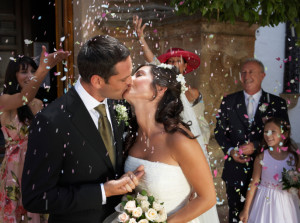 A wedding is one of life’s most momentous events and universally celebrated occasions. Many couples want their big day to reflect their personalities and preferences. This frequently means incorporating religious and cultural traditions significant to them into the festivities.
A wedding is one of life’s most momentous events and universally celebrated occasions. Many couples want their big day to reflect their personalities and preferences. This frequently means incorporating religious and cultural traditions significant to them into the festivities.
India
Indian wedding traditions are often extravagant affairs and the celebrations can last for several days. It is customary for a couple’s wedding attire to be very elaborate, colorful and embellished with gold accents. Many brides also wear multiple gold bangle bracelets. Another tradition is for brides and female attendants to be decorated with intricate henna designs on their hands, arms, feet and legs. It is not uncommon in Indian families for parents to pick their children’s spouses.
Japan
It is customary for Japanese wedding ceremonies to be held in Shinto Shrines. In addition to wearing a white kimono, brides are also typically painted white from head to toe to symbolize their maidenhood. Most Japanese couples also participate in a sake sharing ceremony. The bride and groom drink together to illustrate their union. Parents of the spouses also partake to seal the bond between the two families.
Germany
In Germany, weddings traditions consist of three days of events, but the days are not always consecutive.
- First Day
It is not legal in Germany for a couple to “only” exchange vows in a religious ceremony, so they are married in a civil ceremony on the first day, usually by a justice of peace. Typically only close family and friends attend this ceremony.
- Second Day
A large informal party named the Polterabend occurs on the second day. Polterabend means “evening with broken porcelain.” Old porcelain kitchenware is collected by family and friends and broken in front of the couple for good luck. The tradition is for the couple to clean-up after the party. This is meant to exemplify nothing will ever be broken in their home.
- Third Day
The formal religious ceremony and reception occur on the final day of festivities. Since the couple exchanged vows on the first day and are already legally married, it is customary for them to walk down the aisle together. Usually there is no wedding party or attendants. At the reception following the ceremony, the couple’s first dance is traditionally a waltz.
Morocco
Moroccan weddings are typically celebrated over seven days. On the first day, the bride is painted with henna tattoos and given antique jewelry to wear. She also receives a silver coin for her shoe because, in Morocco, silver is thought to provide protection from evil. Over the next two days, the bride and groom are separated but with their own groups of friends, with whom they celebrate the upcoming nuptials. Muslim couples are married on the fourth day in a private ceremony that only the bride and groom attend. More festivities take place on days five and six before the bride is taken to the home of the groom.
Russia
In Russia, traditional weddings last from two to seven days and there is lots of eating, drinking, dancing and toasting. A humorous Russian wedding custom is for the groom to pay a “ransom” for his bride, which is often jewelry or money. In the Eastern Orthodox Church, it is traditional for couples to be “crowned.” This involves placing crowns on their heads that are worn until the end of the ceremony. Russian couples must also participate in a 15–30 minute civil ceremony where they exchange wedding rings. After this ceremony, parents of the bride and groom usually give them crystal glasses to break for good luck. It is also customary for the couple to release two balloons or doves to symbolize their new life together.
There are many diverse wedding customs. Each signifies something meaningful to people in different parts of the world.

